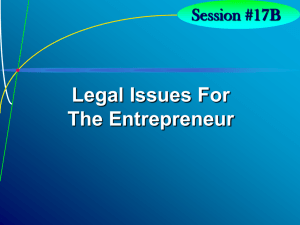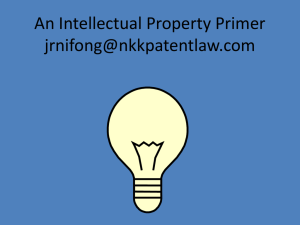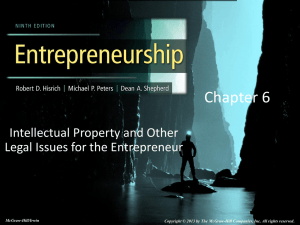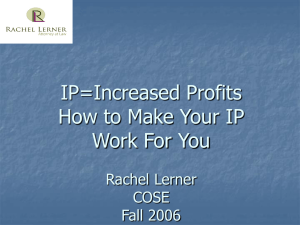Presentation
advertisement
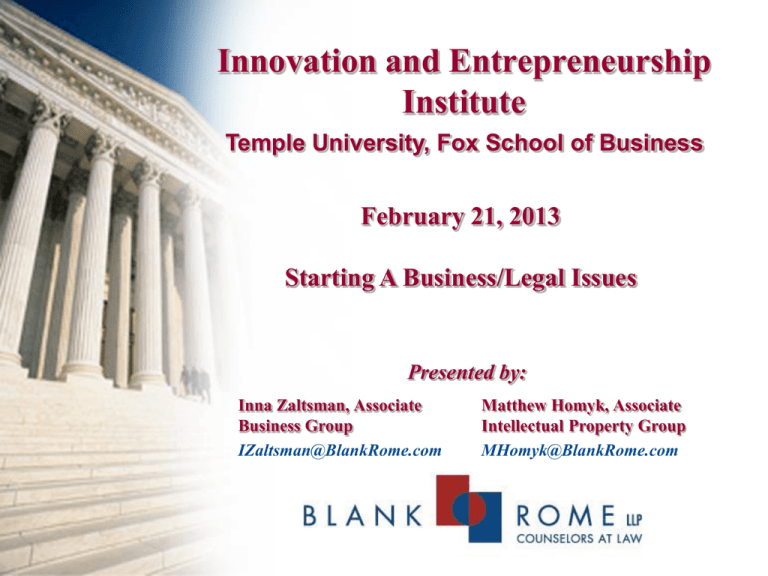
Innovation and Entrepreneurship Institute Temple University, Fox School of Business February 21, 2013 Starting A Business/Legal Issues Presented by: Inna Zaltsman, Associate Business Group IZaltsman@BlankRome.com Matthew Homyk, Associate Intellectual Property Group MHomyk@BlankRome.com CONSIDERATIONS I. II. III. IV. Structuring the Company Legal Pitfalls to Avoid Intellectual Property Issues Tips About Business Plans 2 STRUCTURING THE COMPANY Choice of Entity: • Corporation – “S” vs. “C” corporation • Limited Liability Company (LLC) • Limited Partnership or General Partnership • Sole Proprietorship 3 STRUCTURING THE COMPANY (cont’d) Considerations: • Size/Complexity • Liability • Tax • Funding Needs • Costs (initial and ongoing) • Exit Strategy 4 STRUCTURING THE COMPANY (cont’d) State of Organization: • PA • DE 5 STRUCTURING THE COMPANY (cont’d) Capital Structure: • Classes/Series of Stock • Common, Preferred, Convertible Preferred, Convertible Debt • Warrants/Options • Balance Sheet 6 STRUCTURING THE COMPANY (cont’d) Constituencies: • Shareholders/Stockholders or Members • Board of Directors vs. Board of Advisors • Bylaws/Operating Agreement • Advisory Boards 7 STRUCTURING THE COMPANY (cont’d) Important Agreements: • • • • Shareholders Operating Agreements Employment/Consulting Agreements License Agreements Customer Contracts 8 FINANCING THE BUSINESS • • • • • Founder, Family and Friends Angel Investors Venture Funds Valuation/Performance Measures Loans (Bridge Loans/Bank Loans) 9 OTHER IMPORTANT CONSIDERATIONS • Insurance • Employees: – Confidentiality – Non-Compete – Non-Solicitation • Licensing Issues: – Zoning – Permits • Corporate Governance 10 LEGAL PITFALLS • • • • • • • Bad Advice Unprotected IP Sloppy Records Wrong Structure Personal Liability Oral Agreements Employment Issues 11 INTELLECTUAL PROPERTY ISSUES Identify Your Intellectual Property Assets • Trademarks • Copyrights • Patents • Trade Secrets • Domain Names 12 TRADEMARKS • Must be a distinctive indicia of source of goods or services • Ownership vests upon use in U.S.; vests upon use and registration in other countries 13 TRADEMARKS (cont’d) • Examples – – – – – – – Trademarks Service Marks Trade Names Logos Slogans Domain Names Trade Dress 14 TRADEMARKS (cont’d) • BIG MAC® is a trademark for sandwiches: 15 TRADEMARKS (cont’d) • MCDONALDS® is a service mark for restaurant services: 16 THE APPLICATION PROCESS • A federal registration is obtained by filing an application with the U.S. Patent and Trademark Office. – There is a government filing fee of $325 for each class of goods or services protected filed electronically; $375 for paper filing. – The process typically takes about one year. 17 SELECTING THE FORM OF THE MARK • Registration in block form provides the broadest protection and is the easiest to maintain – any use of the mark will support the Affidavit of Use required to maintain the registration. • Registration in stylized form can be easier to obtain, because the applicant can rely on the distinctiveness of the stylized format. 18 WHAT CAN BE A MARK? • Words, such as COCA-COLA®, and also symbols such as the word COCA-COLA in its distinctive script: 19 WHAT CAN BE A MARK? (cont’d) • Reg. No. 2,418,340 protects the domain name OLDNAVY.COM for computerized retail services: OLDNAVY.COM® 20 WHAT CAN BE A MARK? (cont’d) • Reg. No. 925,609 protects the colors orange, brown and yellow as used on Reese’s peanut butter cups: 21 PROPER USE OF THE MARK • Proper use of a mark is also important to maintaining the mark. – Use marks distinctively – Use marks consistently – Use marks as adjectives (not nouns, i.e. “Xerox”) – Use helper words such as “brand” 22 COPYRIGHTS • Protects works of authorship including literary, dramatic, musical and artistic works • Copyrights vests in author upon creation of work • Provides protection for the life of the author plus 70 years, or if author is unknown or it was a work made for hire, 95 years from publication or 120 years from creation (whichever is first) 23 COPYRIGHTS (cont’d) • Examples – – – – – – Software Documentation and training manuals Advertising materials Models/Prototypes Music Websites 24 MARK VERSUS COPYRIGHT • Copyright does not protect useful articles, and thus copyright protection was denied for this bicycle rack: • Although it is possible to claim trademark protection in the non-functional configuration of a useful article (i.e., as trade dress) 25 PATENTS • Protects new and useful inventions • Title vests initially in inventor • The patent “claims” outline the boundaries of the invention – the claims are what is protected by the patent 26 PATENTS (cont’d) • There are three types of patents: – Utility patents, which protect machines, products, methods or processes, and compositions – Design patents, which protect the aesthetic appearance of products – Plant patents, which protect plants 27 PATENTS (cont’d) • Utility Patent examples – – – – Compositions of matter Devices Methods or processes New uses or applications • Design Patent example 28 MARKS VERSUS PATENTS • Utility patents protect the way something is constructed or how it functions, so there is little overlap with trademarks, which must be primarily non-functional. • Design patents protect the appearance of a product, which can also be a trademark or service mark. 29 COST COMPARISON • Government fees for: – Copyright application = $30 – Trademark application = $325 minimum (depending on number of classes) – Patent application = $300 - $800 (depending on number of claims, type of entity) • While costs vary greatly, copyright protection typically costs less than trademark and patent, with patent protection generally being the most involved and expensive. 30 TRADE SECRETS • Proprietary information that is the subject of reasonable efforts to preserve secrecy and has value because it is not generally known. 31 TRADE SECRETS (cont’d) • Examples – Chemical formulae (CocaCola®) – Customer Lists – Supplier Lists – Software/Algorithms 32 Trade Secrets (con’t) • “Reasonable efforts” to preserve secrecy include: – Limiting access to the trade secret to key employees who have a need to know – Requiring employees to sign a confidentiality agreement – Stamping the word “confidential” on the documents and keeping them in a secure location – Employing computer access passwords and physical barriers 33 TRADE SECRETS (cont’d) • Inadvertent disclosure destroys trade secret protection: – Inadvertent trade show discussions/disclosures – Discussions with vendors and/or competitors – Presentations and Publications – Confidential discussions overheard in public environment – Blogging, work discussions with friends, at dinner, etc. – Interviews with Media, Analysts, Commentators 34 TYPICAL IP PROBLEMS • Oral Agreements (ownership and obligations unclear) • Ownership (vs. license) – Joint Ownership – Work for Hire • Online Agreements • Chain of Title • Inadequate Security 35 TIPS ABOUT BUSINESS PLANS • Lack of Good Executive Summary • Lingo/Buzzwords/ Incomprehensibility • Fluff About Customers, Partners and Key Contracts 36 TIPS ABOUT BUSINESS PLANS (cont’d) • Wild Statements About the Market, Market Size or Competition • Bad Financials or Projections • Evidence of Sloppy Records, Legal Arrangements, Sloppy Plans, Typos 37 TIPS ABOUT BUSINESS PLANS (cont’d) • Hedging Bets on Revenue Model or Channels of Distribution or Some Other Essential Element • Sources and Uses Unclear. What Do You Do? What Do You Want? How Will You Spend It? 38 Questions? 39
